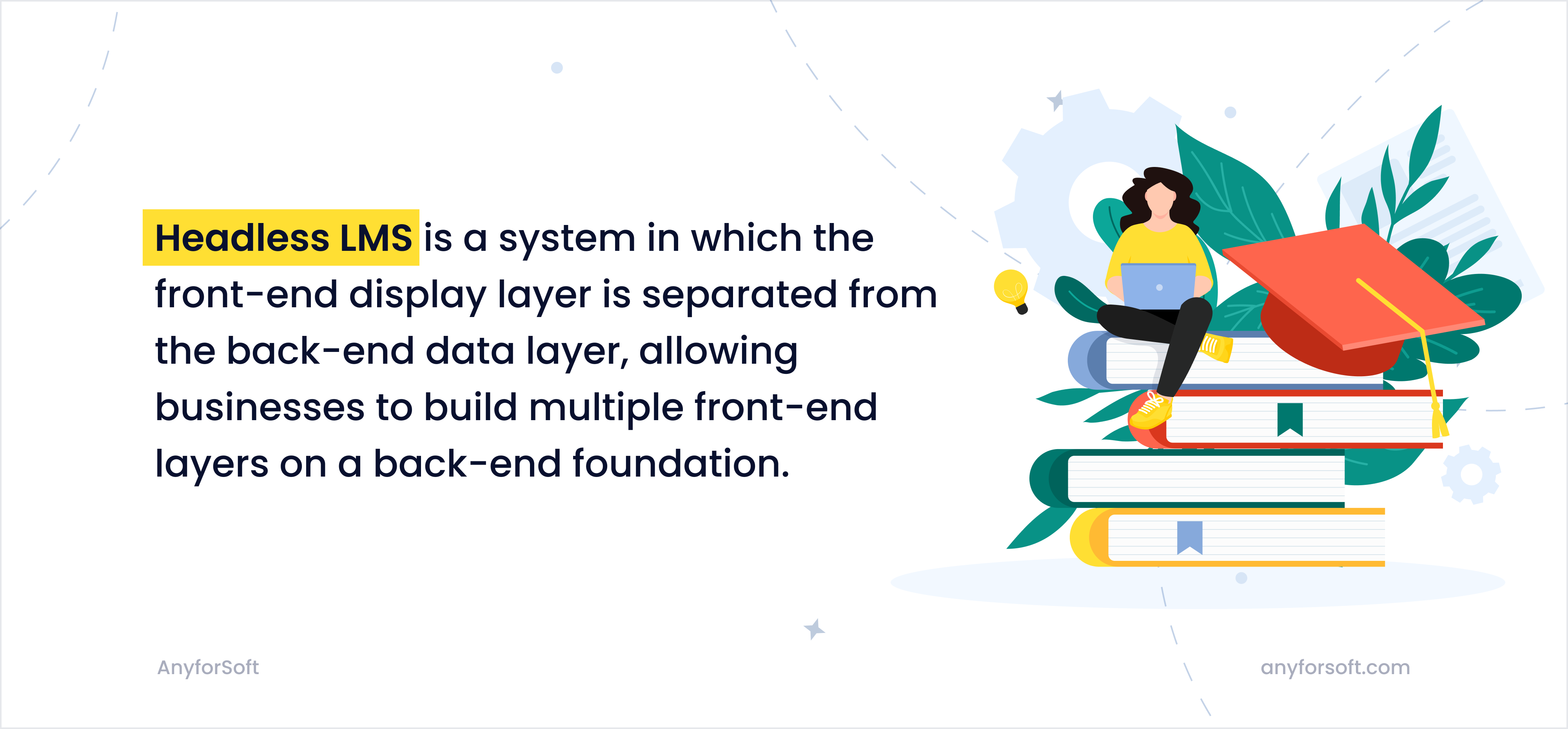Learning management systems continue to evolve to meet the ever-changing needs of modern businesses. Today many organizations aim to deliver highly personalized learning experiences, publish content across multiple channels, and seamlessly integrate their platforms with other applications to gain more touchpoints with learners. The relatively new headless LMS approach allows them to achieve that while breaking the boundaries of traditional systems. It enables the creation of unique presentation layers tailored to each channel, device, and platform a business targets.
But let’s not rush things. If you’ve never heard of headless architecture, you probably have no idea what we’re talking about. Don’t worry—this article explains what a headless learning management system is and whether it’s the right approach for your business. As seasoned LMS developers with over a decade of experience, we’re here to cover:
- What a headless LMS is and how it works;
- Benefits of going headless;
- Challenges of the approach;
- Examples of headless platforms.
Without further ado, let’s get started!
What is a headless LMS?
To understand a headless LMS, we need to take a look at the traditional approach first.
So normally, a system consists of a front end (also referred to as “head” or presentation layer) and a back end (“body” or data layer). The back end handles data processing and server infrastructure while the front end is responsible for the presentation of content and focuses on aspects users can see and interact with. Most learning management systems are built with a unified approach, meaning they’re monolithic and have both a back end and a front end.
However, headless LMS solutions have gained a lot of traction lately due to their highly customized nature. In those systems, the front-end display layer is separated or “decoupled” from the back-end processes, and the two communicate via APIs. This approach allows businesses to build custom front-end learner experiences on top of the back-end foundation. Instead of relying on a single ready-made presentation layer (which may not be optimized for the devices and platforms an organization targets), they can design multiple customized interfaces for each channel, allowing for a personalized and cohesive learner experience.

Let’s explore the opportunities headless LMSs can open for your businesses.
Headless LMS: benefits for your business
Even though headless technology has been around for many years, it’s relatively new when it comes to learning software. Despite this, there are already many decoupled solutions that offer various benefits to businesses willing to break free of the rigid boundaries of traditional platforms. These benefits include:
Omni-channel presence
Headless LMS is perfect for your business if you aim for omni-channel presence and want to be able to reach your learners beyond desktop and mobile devices. It allows you to publish learning content across multiple channels and ensure it’s well-optimized for each one. The technology will give you the freedom to deliver training materials to most devices with an operating system and internet access, be it smartwatches, IoT solutions, augmented reality devices, VR headsets, smart TVs, and so on.
You can engage learners in ways that aren’t possible with traditional learning management systems and create dynamic and interactive learning experiences. Additionally, you will be able to stay ahead of technological advancements and integrate new devices and platforms into your software with minimal disruptions to existing systems.
Seamless integrations
LMS integrations enable you to connect with third-party and internal tools you use to create a centralized learning environment with all the critical training data and learning resources at hand. However, when it comes to traditional architecture, you’re somewhat limited in that regard. Changes in the front end may require significant adjustments to the back end, making it challenging to integrate with evolving technologies. The decoupled approach, on the other hand, allows you to be more flexible in connecting with various systems, as the presentation layer can be customized or replaced without impacting the back-end functionalities.
With a headless LMS, you will be able to connect with any tool of your choice via APIs, integrating the educational content directly into the tools your learners are using. That way, you can create a seamless learning experience that doesn’t require your target audience to switch back and forth between multiple applications.
Future-proof system
As your business grows, you may require more delivery channels. If you rely on a traditional LMS, it may not support these channels, forcing you to initiate a costly LMS migration to a new learning system. In contrast, a headless LMS is designed with flexibility and scalability in mind. Its decoupled architecture allows you to easily integrate new delivery channels and technologies as they emerge. Whether it’s virtual reality, augmented reality, or the latest mobile devices, a headless LMS can adapt to these changes without the need for a complete system overhaul. This ensures that your learning infrastructure remains current and capable of meeting evolving business needs, saving you time and resources while providing a seamless experience for your learners.
Challenges of a headless LMS
Unfortunately, a headless LMS is not all sunshine and rainbows. The decoupled approach presents some serious challenges that you should be aware of before making your LMS headless:
- First of all, the initial implementation cost will be considerably higher than that of a traditional LMS. To optimize your solution for multiple delivery channels, you have to create a tailored user interface for each channel, which naturally entails additional expenses. It requires the attention of UX designers, graphic designers, front-end developers, and project managers. With so many parties involved, it increases the cost and time of initial implementation.
- Secondly, the new technology calls for new educational material formats. Of course, headless LMSs are SCORM-compliant, but while SCORM compliance supports interoperability, it doesn’t address how content will look or perform on all types of devices you target. If you were to optimize your learning programs for, say, VR headsets, there is no guarantee that your content will look good there. All we want to say is that while you can still use a headless LMS for its integration capabilities, tailor-made looks, and personalized learner experience, you will likely face some limitations in content distribution channels.
- Last but not least, the more front-end presentation layers you have, the more difficult, time-consuming, and costly it is to maintain them. Each front-end layer requires ongoing updates, bug fixes, and compatibility checks to ensure a consistent and smooth learner experience.
Examples of headless learning management systems
Now that you know what headless LMS software solutions are about and their benefits and limitations, let’s get acquainted with some popular decoupled systems.
#1 Absorb Infuse
Absorb Infuse is a headless SaaS LMS that allows businesses to improve learner productivity by providing their learners with instant access to microlearning courses. You can seamlessly integrate their solution with frequently used business applications for ubiquitous learning with personalization, security, and scalability. Absorb Infuse boasts custom configurations, SSI and API integrations, flexible reporting, and robust data security.
#2 Create LMS
Create LMS is headless LMS software for enterprises and government organizations. With over 1,000,000 active users, it is highly customizable and can be tailored to the unique requirements of your business. The platform is easy to use and highly secure, as evidenced by zero downtime since 2015. It allows for faster onboarding, more effective employee training, increased learner retention, and better learning outcomes.
#3 Adobe Learning Manager
Adobe Learning Manager is an award-winning LMS with headless capabilities. It allows you to scale and diversify your learning programs, build personalized learning experiences, enrich your course library with over 86,000 courses from the content marketplace, and get actionable insights from detailed reporting. Adobe Learning Manager has been a leader in learning management software for multiple consecutive years, recognized as the best LMS by G2, eLearning Industry, and other reputable organizations.
Conclusion
Headless LMS has the potential to change the e-learning industry and the ways we interact with and deliver learning content. The technology allows us to establish omni-channel presence, seamlessly integrate with other business applications, and build a future-proof system that can scale with our needs. At the same time, it poses many challenges, including high implementation costs, content distribution limitations, and costly maintenance and support. Whether to use it or not is entirely up to you.
If you can’t decide between a headless LMS and a traditional solution, feel free to reach out to us. We’ve been providing LMS consulting services for many years, helping SMEs and large enterprises achieve their goals and objectives. We will analyze your requirements and current infrastructure to recommend the best solution for your organization. We’ll guide you through the decision-making process and ensure you have a system that aligns with your unique training needs.
Contact us today to book your free consultation.








